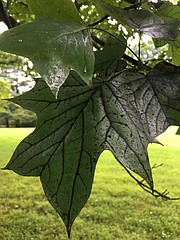Black "sooty mold" covers the front walk of Katherine Chen's Potomac home. The black sticky substance comes from droppings from Tulip Poplar aphids. Photo shows before and after Chen power washed her walkway. Photo by Katherine Chen
A Potomac resident sought help in solving the mystery of the sticky black mess that was covering her patio, driveway, and plants.
“I have lived in Potomac for the past 30 years,” Katherine Chen wrote. “This year I have noticed that the oak trees in my yard (have a lot) are dripping an especially excessive amount of honeydew/sap. This seems to result in black sooty mold on some of the plants that the residue drips on. The sticky residue is covering everything — other plants, grass, outdoor furniture etc. I have walked around and noticed that most of the neighborhood oak trees have this issue and that everything under and around them is covered in the sticky ‘syrup.’ I am wondering what is up, is there an oak tree disease in Potomac? Will this residue damage the other plants that it covers? Is there anything that can be done?”
A visit to the Burbank Drive home of Katherine and Tom Chen revealed tall Tulip Poplars, not oak trees, with black leaves, small growths on the branches, and the troublesome sticky substance coating the leaves and branches.
Tom Chen explained that because it was a rainy day, most of the sticky substance that you can feel while walking on the front path and driveway had been washed away but it would be back when the sun came out.
“I did some research,” Katherine Chen said. “I guess it’s called sooty mold. There is some kind of bug that eats [the leaves] and poops and the ground is very sticky. Its killing all the trees.”
Katherine Chen was not able to connect the dots between bugs, their poop, the sticky substance and the health of the trees.
Two volunteers with Montgomery County Master Gardeners put it all together at a plant clinic held each Saturday during the growing season at Quince Orchard Library in Gaithersburg.
Samples of leaves and a small branch from the Chen’s trees were viewed by Sally Byrne and Mary McKnight at the plant clinic.
“These are great samples,” they said.
“It’s a bad case of sooty mold,” Byrne said immediately. “If it’s sticky, it’s generally aphids.”
It turns out that the aphids, which are small plant-sucking insects, generally ingest too much sap from their host plants and excrete a clear sticky fluid.
The droppings are called honeydew and that grows the black sooty mold, according to Mike DeGregorio, an arborist with Bartlett Tree Experts in Rockville.
Most likely the Chen’s trees have Tulip Poplar aphids, he said.
“Generally, they are not really harmful, more of a nuisance than anything,” DeGregorio said. “And it is treatable.”
He said he has seen a lot of the sooty mold this year.
“It seems like it’s worse this year than it has been,” he said. “The winter is just not getting cold enough to kill off the overwintering insects.”
Katherine Chen said she is happy to hear the problem is treatable and will be hoping for colder winters to come.

